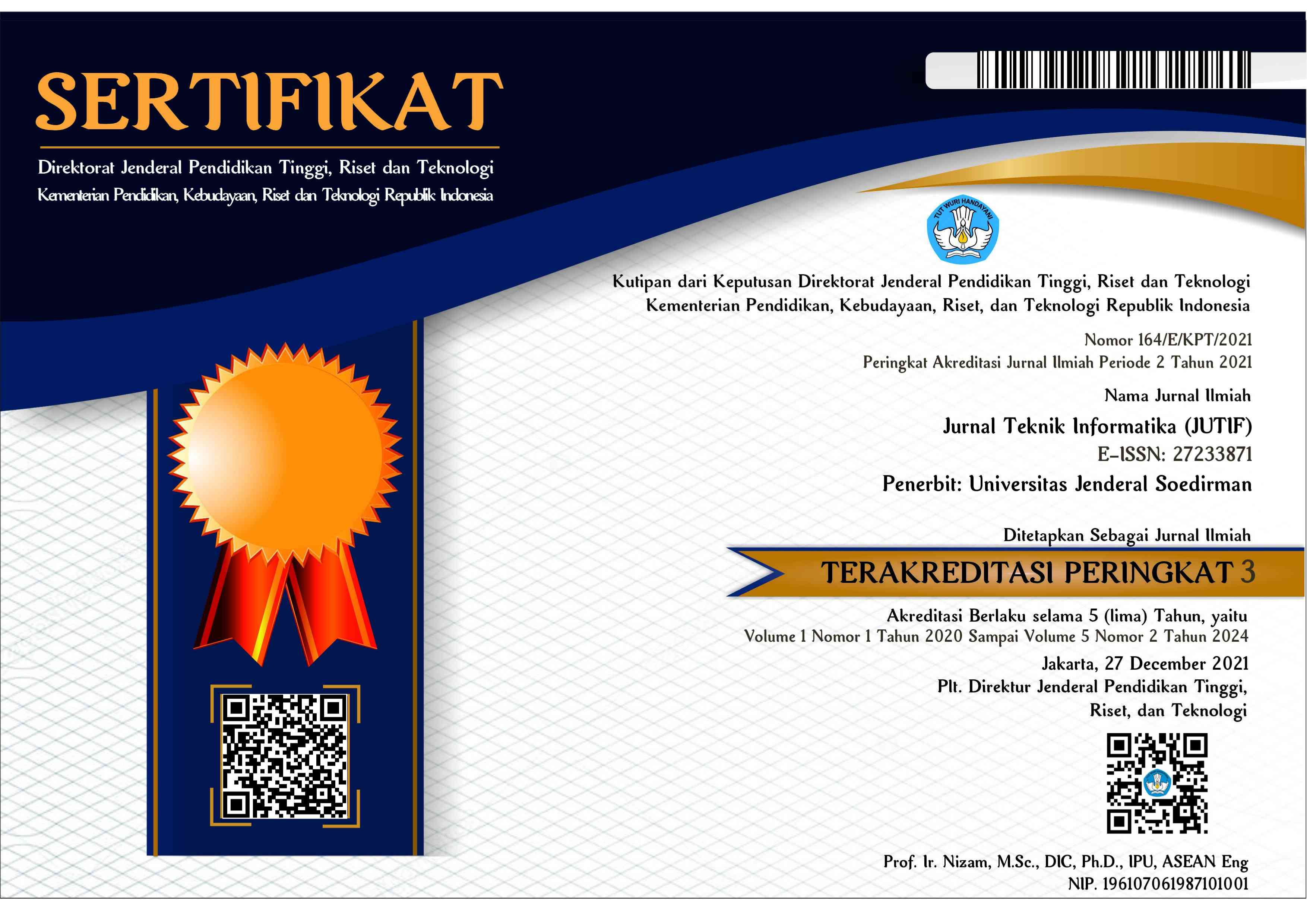ANALYSIS OF IMPLEMENTATION OF PARTICLE SWARM OPTIMIZATION (PSO) METHOD ON LECTURERS ASSIGNMENTS TO STUDENTS
Abstract
When preparing a program for a conference, it is very important to divide teaching and learning tasks according to the areas in which you are involved for teaching and learning to be effective. At the University, the assignment process is still done manually which is very time consuming. Therefore, an appropriate optimization method is needed to handle this. This problem can be solved using a population-based heuristic approach, Particle Swarm Optimization (PSO) has been applied to various fields such as scheduling and assignment. The data used in this research is lecturer assignment data in the form of prioritizing lecturer interest in teaching certain subjects. Based on the calculation results, a test was carried out to determine the effect of the test parameters on the fitness value obtained. From the results of the PSO parameter test, the best number of particles is 100, the best number of repetitions is 100, and the speed combination parameters c1 and c2 are 1.5 and 1.5 with the appropriate value of 94878. The system results, the solution obtained gives good results, i.e. always within tolerance limits, the error scores obtained by placing teachers on subjects that suit their preferences are lower
Downloads
References
P. Chakraborty, P. Mittal, M. S. Gupta, S. Yadav, dan A. Arora, “Opinion of students on online education during the COVID-19 pandemic,” Hum. Behav. Emerg. Technol., vol. 3, no. 3, 2021, doi: 10.1002/hbe2.240.
Ellyzabeth Sukmawati, Iwan Adhicandra, dan Nur Sucahyo, “Information System Design of Online-Based Technology News Forum,” Int. J. Artif. Intell. Res., vol. 1.2, Des 2022, doi: https://doi.org/10.29099/ijair.v6i1.2.593.
B. Agnesiana, D. Mahendika, S. Rumfot, dan E. Sukmawati, “The Analysis of Teacher Efforts to Developing Students Interpersonal and Intrapersonal Intelligence in Learning Activities,” J. Educ., vol. 05, no. 04, hal. 11661–11666, 2023.
Y. Duan, N. Chen, L. Chang, Y. Ni, S. V. N. S. Kumar, dan P. Zhang, “CAPSO: Chaos Adaptive Particle Swarm Optimization Algorithm,” IEEE Access, vol. 10, 2022, doi: 10.1109/ACCESS.2022.3158666.
H. Liu, B. Wu, A. Maleki, dan F. Pourfayaz, “An improved particle swarm optimization for optimal configuration of standalone photovoltaic scheme components,” Energy Sci. Eng., vol. 10, no. 3, 2022, doi: 10.1002/ese3.1052.
A. Iqbal, D. Ying, A. Saleem, M. A. Hayat, dan M. Mateen, “Proposed particle swarm optimization technique for the wind turbine control system,” Meas. Control (United Kingdom), vol. 53, no. 5–6, 2020, doi: 10.1177/0020294020902785.
L. Zhang, H. Zheng, Q. Hu, B. Su, dan L. Lyu, “An Adaptive Droop Control Strategy for Islanded Microgrid Based on Improved Particle Swarm Optimization,” IEEE Access, vol. 8, 2020, doi: 10.1109/ACCESS.2019.2960871.
T. M. Shami, A. A. El-Saleh, M. Alswaitti, Q. Al-Tashi, M. A. Summakieh, dan S. Mirjalili, “Particle Swarm Optimization: A Comprehensive Survey,” IEEE Access, vol. 10, 2022, doi: 10.1109/ACCESS.2022.3142859.
L. Vanneschi dan S. Silva, “Particle Swarm Optimization,” in Natural Computing Series, 2023. doi: 10.1007/978-3-031-17922-8_4.
A. P. Piotrowski, J. J. Napiorkowski, dan A. E. Piotrowska, “Population size in Particle Swarm Optimization,” Swarm Evol. Comput., vol. 58, 2020, doi: 10.1016/j.swevo.2020.100718.
P. Asaah, L. Hao, dan J. Ji, “Optimal Placement of Wind Turbines in Wind Farm Layout Using Particle Swarm Optimization,” J. Mod. Power Syst. Clean Energy, vol. 9, no. 2, 2021, doi: 10.35833/MPCE.2019.000087.
D. Wang, D. Tan, dan L. Liu, “Particle swarm optimization algorithm: an overview,” Soft Comput., vol. 22, no. 2, 2018, doi: 10.1007/s00500-016-2474-6.
J. Peng, Y. Li, H. Kang, Y. Shen, X. Sun, dan Q. Chen, “Impact of population topology on particle swarm optimization and its variants: An information propagation perspective,” Swarm Evol. Comput., vol. 69, 2022, doi: 10.1016/j.swevo.2021.100990.
A. P. Piotrowski dan A. E. Piotrowska, “Differential evolution and particle swarm optimization against COVID-19,” Artif. Intell. Rev., vol. 55, no. 3, 2022, doi: 10.1007/s10462-021-10052-w.
D. Sedighizadeh, E. Masehian, M. Sedighizadeh, dan H. Akbaripour, “GEPSO: A new generalized particle swarm optimization algorithm,” Math. Comput. Simul., vol. 179, 2021, doi: 10.1016/j.matcom.2020.08.013.
J. C. Mba dan M. M. Mai, “A Particle Swarm Optimization Copula-Based Approach with Application to Cryptocurrency Portfolio Optimisation,” J. Risk Financ. Manag., vol. 15, no. 7, 2022, doi: 10.3390/jrfm15070285.
F. Pace, A. Santilano, dan A. Godio, “A Review of Geophysical Modeling Based on Particle Swarm Optimization,” Surveys in Geophysics, vol. 42, no. 3. 2021. doi: 10.1007/s10712-021-09638-4.
C. Chen dan C. Li, “Process Synthesis and Design Problems Based on a Global Particle Swarm Optimization Algorithm,” IEEE Access, vol. 9, 2021, doi: 10.1109/ACCESS.2021.3049175.
F. Wang, H. Zhang, dan A. Zhou, “A particle swarm optimization algorithm for mixed-variable optimization problems,” Swarm Evol. Comput., vol. 60, 2021, doi: 10.1016/j.swevo.2020.100808.
M. Sharif et al., “Recognition of different types of leukocytes using YOLoV2 and optimized bag-of-features,” IEEE Access, vol. 8, 2020, doi: 10.1109/ACCESS.2020.3021660.
F. Buonamici, M. Carfagni, R. Furferi, L. Governi, A. Lapini, dan Y. Volpe, “Reverse engineering of mechanical parts: A template-based approach,” J. Comput. Des. Eng., vol. 5, no. 2, 2018, doi: 10.1016/j.jcde.2017.11.009.
Copyright (c) 2023 Dhiesky Chaerullah, Iqbal Chalid, Achmad Solichin

This work is licensed under a Creative Commons Attribution 4.0 International License.




























